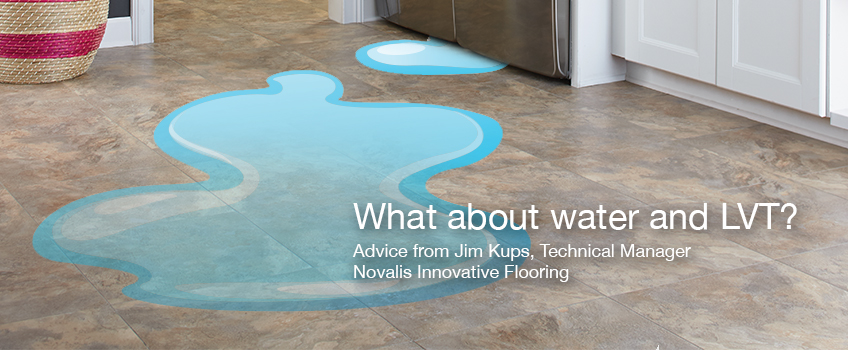It’s often been said that water is the homeowner’s worst nightmare. With that in mind, we asked our own Jim Kups, Novalis Innovative Flooring Technical Manager for North America, to answer some homeowner questions we’ve heard about when NovaFloor luxury vinyl flooring (or any LVT, for that matter) and water come in contact with each other over an extended period to time …
Q: My water heater sprang a leak and totally soaked our LVT floor while we were away for the weekend. It wasn’t a flood, but there was a film of water across a big portion of our floor that had probably been there for about 24 hours. Is our floor ruined? What can we do to determine the damage, if any?
A: No damage done to the floor! But, we need to determine what type of floor was installed. Is it a direct glue product or a floating LVT? Here’s the difference and any potential issues:
DIRECT GLUE: You could see some lifting of planks along the edges, particularly the short edges. Water can seep into the seams and “washout” the adhesive. If this does happen it can be fairly easily remedied, if only a few planks are affected.
FLOATING: No real worries here. The seams will not allow water or moisture to easily penetrate the locking mechanism so the real worry comes from water that has run under the floor from the edges. Water and moisture that is trapped under the floor will not evaporate on its own so you’ll need to determine if the subfloor is affected and if removal of all or part of the floor is necessary to prevent subfloor damage and any mildewing.
___________________
Q: We live in Minnesota and get a lot of snow. This summer, we replaced the flooring at our entry with LVT. Now I’m concerned about the snow melt when the kids come in and take their boots off. No way can I get to that to clean up the water every time. I do have a mat there, but it gets soaked, too. Should I be concerned? What’s your advice?
A: With a directly glued LVT we are concerned with not only the water penetration of the seams but any rock salt or ice melter that comes in with the snow. These compounds are highly alkaline and will break down the adhesive and cause a failure. Use of a mat will help keep this off the floor and minimalize the amount of water that can seep between the seams.
For floating installations there is no concern with adhesion, but only really with any water that gets around the edges of the floor to the subfloor. If that is not happening then there is not a real concern for the product.
However, you do need to keep in mind that the salts/melters can leave a residue on the top of the floor when the water evaporates. A neutral pH cleaning solution is the best way to remove the residue and before cleaning, always sweep up any debris.
___________________
Q: What kind of flooring would be best for our patio entrance? We have a pool out back and the kids will track in water. I know carpet’s not the best choice, tile won’t work for us and hardwood is too expensive. I’m torn between laminate and LVT. Which one would be better handling the water mess?
A: Well, laminates are good products but not when there will be water due to the swelling that can occur with the core board. I would suggest a floating LVT product for this area with a good bath mat, but make sure it has a PVC backing and not rubber. This will help trap water and minimize any liquids that can run to the edges of the flooring and get to the substrate.
Also, be sure to keep in mind that on floating LVT you need to minimize the exposure to direct sunlight. A suitable window covering should be used to protect the floor during peak direct sunlight times to reduce the amount of thermal expansion of the LVT.
Got a question for Jim about LVT? Send us an email at [email protected]


